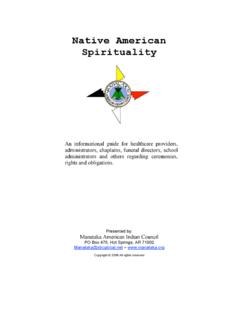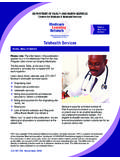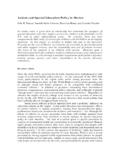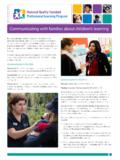Transcription of Cultural and Spiritual Mnemonic Tools 11.06.09
1 Disclaimer The purpose of the Genetic Counseling Cultural Competence Toolkit (GCCCT) is to improve the delivery of culturally responsive, client-centered genetic counseling to diverse populations and to reduce health disparities. The GCCCT is an educational resource; any suggestions do not define the standards of clinical or educational practice. All cases and scenarios are hypothetical. The JEMF, NSGC and Nancy Steinberg Warren, MS, CGC will not be liable for any medical or psychosocial applications connected with the use of or reliance upon any information obtained from this website or associated links and resources.
2 This work has been supported by the Jane Engelberg Memorial Fellowship, the 2009 grant from the Engelberg Foundation to the National Society of Genetic Counselors, Inc. (c) 2010 Nancy Steinberg Warren, MS CGC, all rights reserved 1 Cultural and Spiritual Mnemonic Tools for use in Genetic Counseling This work has been supported by the Jane Engelberg Memorial Fellowship, the 2009 grant from the Engelberg Foundation to the National Society of Genetic Counselors, Inc. (c) 2010 Nancy Steinberg Warren, MS CGC, all rights reserved 2 Table of Contents Cultural Assessment Tools Quick Sheet 3 Full mnemonics 4 ADHERE 4 BATHE 5 ETHNIC(S) 6 ESFT 9 LEARN 11 RESPECT 12 TRANSLATE 13 References 15 Spiritual Assessment Tools Quick Sheet 17 Full mnemonics 18 BELIEF 18 FICA 20 HOPE 21 SPIRIT 23 References 25 This work has been supported by the Jane Engelberg Memorial Fellowship, the 2009 grant from the Engelberg Foundation to the National Society of Genetic Counselors, Inc.
3 (c) 2010 Nancy Steinberg Warren, MS CGC, all rights reserved 3 Cultural Assessment Tools Quick Reference Sheet ADHERE A: Acknowledge D: Discuss H: Handle E: Evaluate R: Recommend E: Empower Soto-Greene, M., Salas-Lopez, D., Sanchez, J., and Like, (2004). Antecedents to Effective Treatment of Hypertension in Hispanic Populations. Clinical Cornerstone, 6(3), 30-36. BATHE B: Background A: Affect T: Trouble H: Handle E: Empathy Stuart , & Lieberman, (1999). The fifteen minute hour: applied psychotherapy for the primary care physician.
4 2nd ed. Westport, Conn.: Praeger. ETHNIC(S) E: Explanation T: Treatment H: Healers N: Negotiate I: Intervention C: Collaborate S: Spirituality Levin , Like , & Gottlieb (2000). ETHNIC: A framework for culturally competent clinical practice. Patient Care, 9 (special issue), 188. ESFT E: Explanatory Model of Health and Illness S: Social and Environmental Factors F: Fears and Concerns T: Therapeutic Contracting (Treatment) Betancourt JR, Carrillo JE, & Green AR. (1999). Hypertension in Multicultural and Minority Populations: Linking Communication to Compliance.
5 Current Hypertension Reports, 1(6), 482-488. LEARN L: Listen E: Explain A: Acknowledge R: Recommend N: Negotiate Berlin, , & Fowkes, Jr. (1983). A teaching framework for cross- Cultural health care. The Western Journal of Medicine, 139(6), 934-8. RESPECT R: Respect E: Explanatory model S: Sociocultural context P: Power E: Empathy C: Concerns and fears T: Therapeutic alliance/ trust Bigby , ed. (2003) Cross- Cultural Medicine, (pp. 20) Philadelphia, PA: American College of Physicians. TRANSLATE T: Trust R: Roles A: Advocacy N: Nonjudgmental S: Setting L: Language A: Accuracy T: Time E: Ethical issues Kaufert and Putsch (1997).
6 Communication through Interpreters in Health care: Ethical Dilemmas Arising from Differences in Class, Culture, Language, and Power. The Journal of Clinical Ethics, 8(1), 71-87. SPEAK S: Speech P: Perception E: Education A: Access K: Knowledge Kobylarz, , Pomidor, A., Heath, (2006). A Mnemonic tool for addressing health literacy concerns in geriatric clinical encounters. Geriatrics, 61(7), 20-26. This work has been supported by the Jane Engelberg Memorial Fellowship, the 2009 grant from the Engelberg Foundation to the National Society of Genetic Counselors, Inc.
7 (c) 2010 Nancy Steinberg Warren, MS CGC, all rights reserved 4 Cultural Assessment Mnemonic Tools ADHERE ADHERE is a Mnemonic tool that can be very helpful for health care providers to gain an understanding of the patient s lifestyle and culture. These key factors of the Mnemonic will help eliminate concerns and questions the patients come across. The treatment plan will be a result of both the patient and health care provider s goals and desires, designed by compromising and discussing important issues together. Acknowledge: Acknowledge the need for treatment with the patient, and ask about previous treatments utilized.
8 Together determine mutual goals and desired outcomes. Discuss: Discuss potential treatment strategies and options, as well as consequences of non-treatment with the patient (consider issues such as treatment effectiveness, prognosis, use of complementary/ alternative medicine, brand name vs. generics, off-label uses, prescription plans, formularies, etc.). Handle: Handle any questions or concerns the patient may have about treatment ( , fears or worries, side effects, costs, dosage, frequency, timing, sequence, duration of treatment, drug or food interactions, and proper storage techniques).
9 Evaluate: Evaluate the patient s functional health literacy and understanding of the purpose/rationale for treatment, and assess barriers and facilitators to adherence ( , environmental, economic, occupational, and sociocultural factors, family situation and supports) Recommend: Recommend treatment, and review the therapeutic regimen with the patient. Empower: Empower by eliciting the patient s commitment and willingness to follow-through with the therapeutic regimen. Originally referenced: Soto-Greene, M., Salas-Lopez, D., Sanchez, J., and Like, (2004) Antecedents to Effective Treatment of Hypertension in Hispanic Populations.
10 Clinical Cornerstone, 6(3), 30-36. Reference (2002) Appendix A: The Toolbox. Transforming the Face of Health Professions Through Cultural & Linguistic Competence Education: The Role of the HRSA Centers of Health Resources and Services Administration. Retrieved October 29, 2009 from This work has been supported by the Jane Engelberg Memorial Fellowship, the 2009 grant from the Engelberg Foundation to the National Society of Genetic Counselors, Inc. (c) 2010 Nancy Steinberg Warren, MS CGC, all rights reserved 5 BATHE BATHE can be a useful device for physicians and health care providers to use with patients to discover the core issue or problem.










